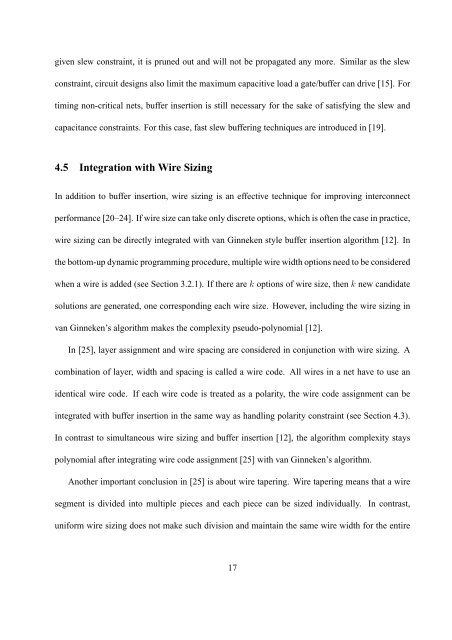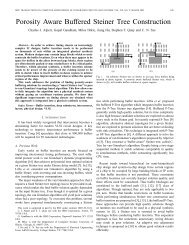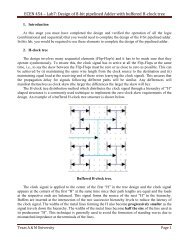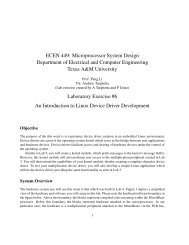Buffer Insertion Basics - Computer Engineering & Systems Group ...
Buffer Insertion Basics - Computer Engineering & Systems Group ...
Buffer Insertion Basics - Computer Engineering & Systems Group ...
You also want an ePaper? Increase the reach of your titles
YUMPU automatically turns print PDFs into web optimized ePapers that Google loves.
given slew constraint, it is pruned out and will not be propagated any more. Similar as the slew<br />
constraint, circuit designs also limit the maximum capacitive load a gate/buffer can drive [15]. For<br />
timing non-critical nets, buffer insertion is still necessary for the sake of satisfying the slew and<br />
capacitance constraints. For this case, fast slew buffering techniques are introduced in [19].<br />
4.5 Integration with Wire Sizing<br />
In addition to buffer insertion, wire sizing is an effective technique for improving interconnect<br />
performance [20–24]. If wire size can take only discrete options, which is often the case in practice,<br />
wire sizing can be directly integrated with van Ginneken style buffer insertion algorithm [12]. In<br />
the bottom-up dynamic programming procedure, multiple wire width options need to be considered<br />
when a wire is added (see Section 3.2.1). If there are k options of wire size, then k new candidate<br />
solutions are generated, one corresponding each wire size. However, including the wire sizing in<br />
van Ginneken’s algorithm makes the complexity pseudo-polynomial [12].<br />
In [25], layer assignment and wire spacing are considered in conjunction with wire sizing. A<br />
combination of layer, width and spacing is called a wire code. All wires in a net have to use an<br />
identical wire code. If each wire code is treated as a polarity, the wire code assignment can be<br />
integrated with buffer insertion in the same way as handling polarity constraint (see Section 4.3).<br />
In contrast to simultaneous wire sizing and buffer insertion [12], the algorithm complexity stays<br />
polynomial after integrating wire code assignment [25] with van Ginneken’s algorithm.<br />
Another important conclusion in [25] is about wire tapering. Wire tapering means that a wire<br />
segment is divided into multiple pieces and each piece can be sized individually. In contrast,<br />
uniform wire sizing does not make such division and maintain the same wire width for the entire<br />
17
















